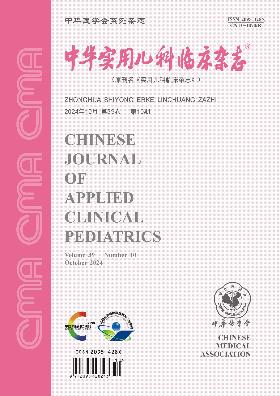Toll样受体4在特发性肾病综合征患儿肾组织和外周血中的表达及意义
Q4 Medicine
引用次数: 0
摘要
目的探讨Toll样受体4(TLR4)在儿童原发性肾病综合征(INS)肾组织和外周血中的表达及其意义。方法收集2015年10月至2018年6月在新乡医科大学第一附属医院确诊的78例INS患儿的肾活检组织和21例正常儿童(对照组1)的肾组织,采用免疫组织化学方法检测肾组织中TLR4的表达。比较TLR4在不同肾脏病理类型和临床类型INS中的表达,分析TLR4与24小时尿蛋白和血清白蛋白的相关性。采用酶联免疫吸附试验(ELISA)检测INS患儿治疗前后(活动期和缓解期)和23例健康儿童(对照组2)外周血TLR4的表达水平。比较不同肾脏病理类型和临床类型INS患者血清TLR4的表达水平,分析TLR4与24小时尿蛋白和血清白蛋白的相关性;还分析了肾小管和INS患儿血清中TLR4表达的相关性。结果(1)与正常肾组织中TLR4的表达[(0.93±0.26)%]相比,TLR4在所有病理类型的INS的肾小球和间质中的表达无显著差异(F=0.741,P=0.562),但TLR4在肾小管中的表达[MCD:(82.94±4.62)%,MN:(63.54±1.98)%,MsPGN(42.32±2.97)%,FSGS:(22.60±2.07)%]显著增加(F=1929.842,P<0.01),尤其是MCD型INS肾小管中TLR4的表达显著高于MN、MsPGN和FSGS[MCD:%],TLR4在激素敏感性肾病综合征(SSNS)型肾小管表达最高,(2)活动期INS患儿血清TLR4的表达[MsPNG:(143.36±12.99)ng/L,FSGS(75.94±7.29)ng/LMN(210.22±14.66)ng/LMCD(283.93±21.58)ng/L]显著高于缓解期INS患儿[MsPNG:(29.51±4.93)ng/LFSGS(15.66±3.78)ng/L MN(45.40±5.73)ng/L MCD对照组2[(0.69±0.33)ng/L],差异有统计学意义(均P<0.01);缓解期INS患儿血清TLR4表达显著高于对照组2(F=286.287,P<0.01),活动期和缓解期MCD型INS患儿血清中TLR4表达水平最高,其次为MN和FSGS。血清TLR4在SSNS中表达最高,在SRNS中表达最低,(3)INS患儿肾小管TLR4的表达[(62.82±20.94)%]与血清TLR4表达[(213.26±73.33)ng/L]呈正相关(r=0.852,P<0.05)蛋白水平[(123.05±33.55)mg/kg](r=0.401,0.427,均P<0.05),与血清白蛋白水平[(19.54±3.55)g/L]呈负相关(r=-0.602,-0.617,均<0.05)。关键词:Toll样受体4;肾脏组织;血清;特发性肾病综合征;儿童本文章由计算机程序翻译,如有差异,请以英文原文为准。
Expression and significance of Toll-like receptor 4 in renal tissue and peripheral blood of children with idiopathic nephrotic syndrome
Objective
To investigate the expression and significance of Toll-like receptor 4 (TLR4) in renal tissue and peripheral blood of children with idiopathic nephrotic syndrome(INS).
Methods
The renal biopsy tissues of 78 children with INS diagnosed in the First Affiliated Hospital of Xinxiang Medical University from October 2015 to June 2018 and normal renal tissues of 21 children (control group 1) were collected, and the expressions of TLR4 in the renal tissue was detected by using immunohistochemical method.The expression of TLR4 in different renal pathological types and clinical types of INS was compared, and the correlation of TLR4 with 24-hour urinary protein and serum albumin was analyzed.The expression levels of TLR4 in peripheral blood of children with INS before and after treatment (active stage and remission stage) and 23 healthy children (control group 2) were detected by enzyme linked immunosorbent assay(ELISA). The serum expression levels of TLR4 in different renal pathological types and clinical types of INS were compared, and the correlation of TLR4 with 24-hour urinary protein and serum albumin was analyzed; The correlation between TLR4 expression in renal tubules and in the serum of children with INS was also analyzed.
Results
(1)Compared with the expression of TLR4 in normal renal tissues[(0.93±0.26)%], the expression of TLR4 in glomeruli and interstitium of all pathological types of INS [mesangial proliferative glomerulonephritis (MsPGN): (0.93 ± 0.21)%, focal segmental glomerulosclerosis (FSGS): (1.02±0.25)%, membranous glomerulonephritis(MN): (1.03±0.09)%, minimal change disease(MCD): (1.02±0.27)%]was not significantly different (F=0.741, P=0.562), but the expression of TLR4 in renal tubules[MCD: (82.94±4.62)%, MN: (63.54±1.98)%, MsPGN(42.32±2.97)%, FSGS: (22.60±2.07)%] was significantly increased (F=1 929.842, P<0.01), Especially, the expression of TLR4 in renal tubules of MCD type INS was significantly higher than that of MN, MsPG N and FSGS [MCD: (82.94±4.62)%, MN: (63.54±1.98)%, MsPGN: (42.32±2.97)%, FSGS: (22.60±2.07)%], and the differences were statistically significant(all P<0.01). TLR4 expression in renal tubules was the highest in steroid-sensitive nephrotic syndrome (SSNS) type and the lowest in INS patients with steroid-resistant nephrotic syndrome (SRNS) type, and the differences were statistically significant(F=220.951, P<0.01). (2)The expression of serum TLR4 in INS children at the active stage [MsPNG: (143.36±12.99) ng/L, FSGS(75.94±7.29) ng/L, MN(210.22±14.66) ng/L, MCD(283.93±21.58) ng/L]was significantly higher than that in INS children at remission stage [MsPNG: (29.51±4.93) ng/L, FSGS(15.66±3.78) ng/L, MN(45.40±5.73) ng/L, MCD(62.29±7.90) ng/L]and control group 2[(0.69 ± 0.33) ng/L], and the differences were statistically significant(all P<0.01); the expression of serum TLR4 in INS children at remission stage was significantly higher than that in the control group 2 (F=286.287, P<0.01). TLR4 had the highest expression level in serum of MCD type INS children at active and remission stages, followed by MN and FSGS successively.The expression of serum TLR4 was highest in SSNS and lowest in SRNS, and the differences were statistically significant (F=147.438, P<0.01). (3)The expression of TLR4 in renal tubules of children with INS[(62.82 ±20.94)%]was positively correlated with the expression of TLR4 in serum[(213.26±73.33) ng/L] (r=0.852, P< 0.05). The expression levels of TLR4 in renal tubules and serum of INS patients at active stage were positively correlated with 24-hour urinary protein level[(123.05±33.55) mg/kg] (r=0.401, 0.427, all P<0.05), and negatively correlated with serum albumin level[(19.54±3.55)g/L] (r=-0.602, -0.617, all P<0.05).
Conclusions
The expression of TLR4 in renal tubules and serum of children with INS increases, and may be related to different renal pathological types and clinical types of children with INS, as well as disease activity.
Key words:
Toll-like receptor 4; Kidney tissue; Serum; Idiopathic nephrotic syndrome; Child
求助全文
通过发布文献求助,成功后即可免费获取论文全文。
去求助
来源期刊

中华实用儿科临床杂志
Medicine-Pediatrics, Perinatology and Child Health
CiteScore
0.60
自引率
0.00%
发文量
14243
期刊介绍:
Chinese Journal of Applied Clinical Pediatrics ( semi-monthly ) is a core journal of paediatrics under the supervision of China Association for Science and Technology, sponsored by Chinese Medical Association and undertaken by Xinxiang Medical College. Founded in 1986, it is openly circulated both at home and abroad. The journal has several columns, such as Expert Forum, Experimental Research and Paediatric Surgery, which are mainly for paediatric medical workers and medical researchers in hospitals. Its purpose is to reflect the new theories and technologies in paediatric medicine and scientific research at home and abroad, and to promote academic exchanges.
Chinese Journal of Applied Clinical Pediatrics is a source journal of China Science Citation Database (CSCD), a core journal of Peking University, a source journal of Chinese science and technology paper statistics (China Science and Technology Core Journals), a core academic journal of RCCSE, a high-quality scientific and technical journal of China, a high-quality scientific and technical journal of China Association for Science and Technology, and a high-quality scientific and technical journal of China Biomedical Science and Technology Association. We have been published in China Biomedical Literature Database (SinoMed), China Knowledge Network, Wanfang Data Knowledge Service Platform, China Academic Journal Abstracts, Scopus Database, Chemical Abstracts (USA), Japan Science and Technology Agency (JSTA) Database, Copernicus Abstracts (Poland), Abstracts of the Centre for Agricultural and Biological Sciences (CABS) of the United Kingdom, Cambridge Scientific Abstracts ProQuest Database, WHO Medical Journal of the Western Pacific Region (WMPR), and WHO Medical Journal of the Western Pacific Region (WMPR) of the United States. We have been included in dozens of authoritative databases at home and abroad, such as WHO Western Pacific Region Index of Medicine (WPRIM), Ullrich's Guide to Periodicals, and so on.
 求助内容:
求助内容: 应助结果提醒方式:
应助结果提醒方式:


